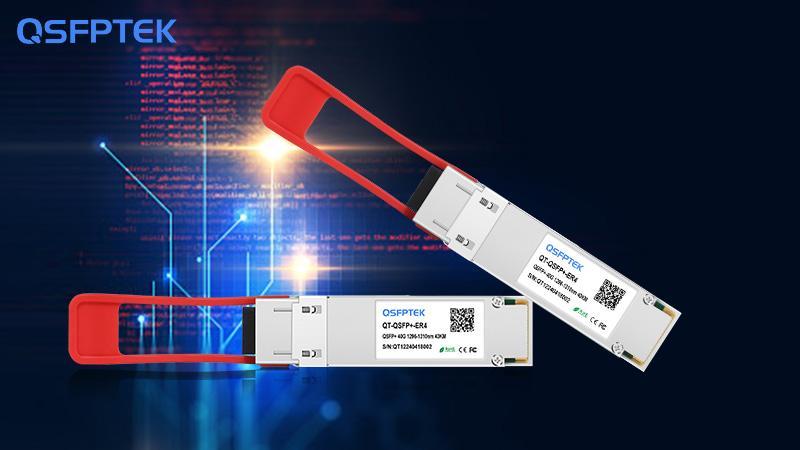Exploring the 40GBASE-ER4 Optical Module: A Long-Distance Solution for High-Speed Networks
In the ever-growing demand for higher data transmission speeds and long-distance connectivity, the 40GBASE-ER4 optical module stands out as a reliable and high-performance solution. Designed for ultra-long-range communication, the 40GBASE-ER4 offers 40Gbps of bandwidth over extended distances, making it an ideal choice for applications in large-scale data centers, telecom networks, and enterprise environments where long-distance, high-speed transmission is essential. This optical module ensures that businesses can meet the increasing need for fast and reliable data transfer while maintaining cost-efficiency and performance.
The 40GBASE-ER4 Optical Module: Form Factor and Key Features
The 40GBASE-ER4 optical module belongs to the QSFP+ (Quad Small Form-factor Pluggable Plus) family, a widely adopted form factor in high-speed networking. QSFP+ modules are designed to offer high-density, compact solutions, and the 40GBASE-ER4 is no exception, providing 40Gbps data rates while utilizing four separate optical channels. This modular design allows network engineers to easily integrate the module into existing switches, routers, and servers without taking up too much space in the hardware.
What sets the 40GBASE-ER4 apart is its remarkable long-range capability. Optimized for single-mode fiber (SMF), this transceiver is capable of supporting distances up to 40 kilometers (km), making it suitable for applications that require reliable, long-haul connectivity. This feature makes the 40GBASE-ER4 an excellent choice for metro-area networks (MANs), wide-area networks (WANs), and long-distance data center interconnects.
Understanding the ER4 Technology: Multi-Wavelength Transmission
The “ER4” designation stands for Extended Range, with the number “4” indicating that the module uses four separate wavelengths of light to transmit data. These wavelengths, operating at 1264.5 nm, 1274.5 nm, 1284.5 nm, and 1294.5 nm, are optimized for single-mode fiber and allow the module to achieve high data throughput over long distances without sacrificing signal integrity. Each of the four wavelengths carries data at a rate of 10Gbps, which is aggregated to provide an overall data rate of 40Gbps.
This multi-wavelength approach allows for efficient and high-capacity transmission, minimizing the potential for interference or signal degradation that can occur over longer distances. The use of multiple channels in the ER4 module not only enhances data integrity but also maximizes the module’s ability to handle high-speed traffic, making it an excellent choice for applications where both high throughput and long reach are critical.
Long-Range Performance and Applications of 40GBASE-ER4
One of the most significant advantages of the 40GBASE-ER4 module is its ability to support transmission distances of up to 40 kilometers, which is considerably longer than other 40Gbps modules, such as the 40GBASE-SR4 or 40GBASE-LR4. This extended range makes the ER4 module ideal for connecting distant data centers, inter-building links, and telecom infrastructures, where high-speed, long-distance communication is required.
Whether used in large-scale data centers or wide-area network environments, the 40GBASE-ER4 provides the reliable, high-performance connectivity needed to handle the growing demands of data-intensive applications, including cloud computing, big data analytics, and video streaming. By enabling fast and efficient data transfer over significant distances, the 40GBASE-ER4 ensures that network traffic can flow smoothly, without interruptions, and with minimal latency.
Power Efficiency and Cost-Effectiveness
The 40GBASE-ER4 module is designed to offer low power consumption, which is a crucial consideration in modern networking. As data centers and telecom companies look to reduce operational costs and increase energy efficiency, the low power consumption of the 40GBASE-ER4 is a significant benefit. This is particularly important for large-scale deployments where managing power consumption can have a substantial impact on both operational costs and the overall environmental footprint of the network infrastructure.
In addition to its energy efficiency, the 40GBASE-ER4 provides a cost-effective solution for long-distance, high-speed transmission. While the initial investment in single-mode fiber may be higher than multimode fiber, the ER4 module allows for high-capacity transmission over much longer distances, eliminating the need for repeaters or additional signal boosting equipment. This translates into cost savings over time, especially for organizations with large or geographically dispersed networks.
Challenges and Considerations
While the 40GBASE-ER4 optical module offers exceptional performance, there are a few challenges to consider. The module is designed to work exclusively with single-mode fiber (SMF), which is generally more expensive and less flexible than multimode fiber (MMF). For organizations that already have an MMF infrastructure, transitioning to SMF may require an additional investment in new cabling and fiber-optic equipment.
Moreover, the installation of long-range fiber-optic links can be more complex than shorter-range setups. Ensuring proper alignment and connection quality is crucial to maintaining the high performance of the 40GBASE-ER4 module. However, these challenges are typically outweighed by the benefits of having a reliable, high-capacity solution for long-distance data transmission.
Conclusion
In conclusion, the 40GBASE-ER4 optical module is an outstanding solution for organizations that need to support high-speed, long-distance communication. With a range of up to 40 kilometers, the ability to transmit data at 40Gbps, and the power efficiency it offers, the ER4 module is an ideal choice for high-performance networks in metro-area and wide-area applications. Its ability to meet the demands of modern data-intensive environments while providing reliable and cost-effective long-range transmission ensures that the 40GBASE-ER4 will continue to be a critical component in the development of next-generation networking infrastructures.
Keep an eye for more news & updates on VerifiedZine!





